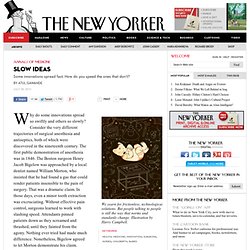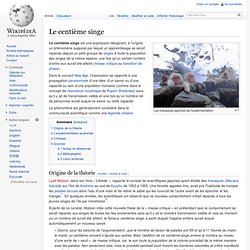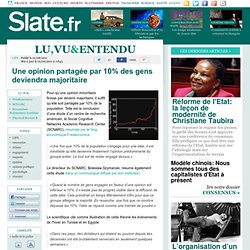

Le phénomène du centième singe. Atul Gawande: How Do Good Ideas Spread? Why do some innovations spread so swiftly and others so slowly?

Consider the very different trajectories of surgical anesthesia and antiseptics, both of which were discovered in the nineteenth century. The first public demonstration of anesthesia was in 1846. The Boston surgeon Henry Jacob Bigelow was approached by a local dentist named William Morton, who insisted that he had found a gas that could render patients insensible to the pain of surgery.
That was a dramatic claim. In those days, even a minor tooth extraction was excruciating. On October 16, 1846, at Massachusetts General Hospital, Morton administered his gas through an inhaler in the mouth of a young man undergoing the excision of a tumor in his jaw. Four weeks later, on November 18th, Bigelow published his report on the discovery of “insensibility produced by inhalation” in the Boston Medical and Surgical Journal. There were forces of resistance, to be sure. Sepsis—infection—was the other great scourge of surgery. Le centième singe. Un article de Wikipédia, l'encyclopédie libre.

Les macaques japonais de l'expérimentation Le centième singe est une expression désignant, à l'origine, un phénomène supposé par lequel un apprentissage se serait répandu depuis un petit groupe de singes à toute la population des singes de la même espèce, une fois qu’un certain nombre d’entre eux aurait été atteint (masse critique ou transition de phase). Dans le courant New Age, l'expression se rapporte à une propagation paranormale d’une idée, d’un savoir ou d’une capacité au sein d'une population humaine (comme dans le concept de résonance morphique de Rupert Sheldrake) sans qu’il y ait de transmission visible et une fois qu’un nombre clé de personnes aurait acquis ce savoir ou cette capacité.
La noosphere ou la théorie du 100° singe... Une opinion partagée par 10% des gens deviendra majoritaire. Pour qu’une opinion minoritaire finisse par devenir majoritaire, il suffit qu’elle soit partagée par 10% de la population.

Telle est la conclusion d’une étude d’un centre de recherche américain, le Social Cognitive Networks Academic Research Center (SCNARC), résumée par le blog économique Freakonomics: «Une fois que 10% de la population s’engage pour une idée, il est inévitable qu’elle devienne finalement l’opinion prédominante du groupe entier. Le tout est de rester engagé dessus.» Le directeur du SCNARC, Boleslaw Szymanski, résume également cette étude dans un communiqué diffusé par son institution: Des chercheurs découvrent un point de basculement dans l’adoption d’idées. Le centième singe. Naissance d’un paradigme. Minority rules: Scientists discover tipping point for the spread of ideas.
Scientists at Rensselaer Polytechnic Institute have found that when just 10 percent of the population holds an unshakable belief, their belief will always be adopted by the majority of the society.

The scientists, who are members of the Social Cognitive Networks Academic Research Center (SCNARC) at Rensselaer, used computational and analytical methods to discover the tipping point where a minority belief becomes the majority opinion. The finding has implications for the study and influence of societal interactions ranging from the spread of innovations to the movement of political ideals.
"When the number of committed opinion holders is below 10 percent, there is no visible progress in the spread of ideas. It would literally take the amount of time comparable to the age of the universe for this size group to reach the majority," said SCNARC Director Boleslaw Szymanski, the Claire and Roland Schmitt Distinguished Professor at Rensselaer. The 100th (Hundredth) Monkey - story about social change (wowzone.com) WOW Poetry, lyrics, music, stories, classics Wish Only Well.
The 100th Monkey Syndrome. Copyrights, Patents, And Trademarks Fade To The 100th Monkey Syndrome How Can There Be Intellectual Ownership?

You have probably heard about the 100th Monkey Syndrome? It's happened many times where a few monkeys in a remote area learn something new that has never been done before by other monkeys. And when this new action has been practiced enough times, suddenly, other monkeys- even in completely different parts of the world- begin doing what was learned by those few monkeys. And they've never even seen it done before! The whole idea about copyrights, patenting and trademarks in the future will likely change due to this phenomena called the 100th Monkey Syndrome. You see that quite often in science where teams in different parts of the world basically make very similar or the same discovery at around the same time. So if your ideas don't belong to you, then how do you copyright them or patent them or trademark a symbol that you got out of thin air?
We all get ideas. What About Patents?